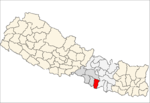The 1991 Nepal census was a widespread national census conducted by the Nepal Central Bureau of Statistics.

Chaukati is a village in Sindhupalchok District in the Bagmati Zone of central Nepal. At the time of the 1991 Nepal census it had a population of 2346 and had 539 houses in the village. By 2011 the population had become 2497 in 627 households.

Maneshwara is a village in Sindhupalchok District in the Bagmati Zone of central Nepal. At the time of the 1991 Nepal census it had a population of 3065 and had 642 houses in the village. By 2011 the population had become 3393 in 789 households.

Pedku is a village in Sindhupalchok District in the Bagmati Zone of central Nepal. At the time of the 2013 Nepal census it had a population of 2284 and had 408 houses in the village. In 2011 the population was 1600 in 391 households.

Bhimdhunga is a village and former Village Development Committee that is now part of Nagarjun Municipality in Province No. 3 of central Nepal. At the time of the 2011 Nepal census it had a population of 2,915 and had 619 houses in it.

Dhapasi is a residentially preferred village and former Village Development Committee that is now part of Tokha Municipality, just outside the Kathmandu Ring Road, in Kathmandu District in Province No. 3 of central Nepal. At the time of the 2011 Nepal census it had a population of 31,406 and had 8,202 households in it.

Gapalphedi is a village and former Village Development Committee that is now part of Kageshwari-Manohara Municipality in Kathmandu District in Province No. 3 of central Nepal. At the time of the 2011 Nepal census it had a population of 5,533 and had 1,166 households in it.

Jorpati is a village and former Village Development Committee that is now part of Gokarneshwar Municipality in Kathmandu District in Province No. 3 of central Nepal. At the 2011 census it had a population of 84,567 making it one of the largest villages in the world. At the time of the 1991 Nepal census it had a population of 10,796 and had 1988 households in it.

Chhoprak is a village development committee in Gorkha District in the Gandaki Zone of northern-central Nepal. At the time of the 2011 Nepal census, it had a population of 5893 and had 1531 houses in the town.

Dhuwakot is a village development committee in Gorkha District in the Gandaki Zone of northern-central Nepal. At the time of the 2011 Nepal census it had a population of 4,259 and had 1,110 houses in the town.

Masel is a village development committee in Gorkha District in the Gandaki Zone of northern-central Nepal. At the time of the 2011 Nepal census it had a population of 12000+ and had 1000+ houses in the town. River Daraundi Club is local origination of city.
Palumtar is a municipality in Gorkha District in the Gandaki Zone of northern-central Nepal. It was named after the former Village Development Committee which now is part of it. At the time of the 1991 Nepal census the VDC had a population of 6,982 and had 1358 houses in the town. The municipality has 23 461 inhabitants according to the census of 2011.

Ravi Opi is a village development committee in Kabhrepalanchok District in the Bagmati Zone of central Nepal. At the time of the 2011 Nepal census it had a population of 4315 in 923 individual households. the VDC office was located at the middle of village named "dudamukh"

Johang is a Village Development Committee VDC in Gulmi District in the Lumbini Zone of Western Nepal. At the time of the 2011 Nepal census it had a population of about 10000 living in 1509 individual households.

Chulachuli is a rural municipality (gaunpalika) out of six rural municipality located in Ilam District of Province No. 1 of Nepal. There are a total of 10 municipalities in Ilam in which 4 are urban and 6 are rural.

Pathari Shanishchare (पथरी-शनिश्चरे) is a Municipality in Morang District in the Koshi Zone of south-eastern Nepal. It was formed by merging two existing village development committees i.e. Pathari and Sanischare in May 2014.
Pakalihawa is a village development committee in Rupandehi District in the Lumbini Zone of southern Nepal. At the time of the 2011 Nepal census it had a population of 63483 people living in 1153 individual households.
The 2001 Nepal census was conducted by the Nepal Central Bureau of Statistics. According to the census, the population of Nepal in 2001 was 23,151,423. Working with Nepal's Village Development Committees at a district level, they recorded data from all the main towns and villages of each district of Nepal. The data included statistics on population size, households, sex and age distribution, place of birth, residence characteristics, literacy, marital status, religion, language spoken, caste/ethnic group, economically active population, education, number of children, employment status, and occupation.

Sundar Haraicha is a municipality in Morang District of Province No. 1 in Nepal that was established on 10 March 2017 by merging the former municipalities Sundar Dulari and Koshi Haraicha. At the time of the 2011 Nepal census, the localities out of which Chaudandigadhi would be formed had a joint population of 80,518 people living in 18,610 individual households.






